By Emily Beck and Katie Minarsich
After the roaring success of our Tunbridge Cakes, and with no end in sight to working from home, we (Assistant Curator Emily Beck and student employee Katie Minarsich) decided to dive back into the manuscript recipe collection of the Wangensteen Historical Library of Biology and Medicine.
Perhaps feeling slightly overconfident, we decided to look for some celebrity guest judges. Thankfully, we managed to convince four University Libraries employees named Lisa (hereafter, the Lisas of the Libraries) to embark upon a journey of deciphering, baking, and eating a 1500s recipe for “French Cheese Cakes.”
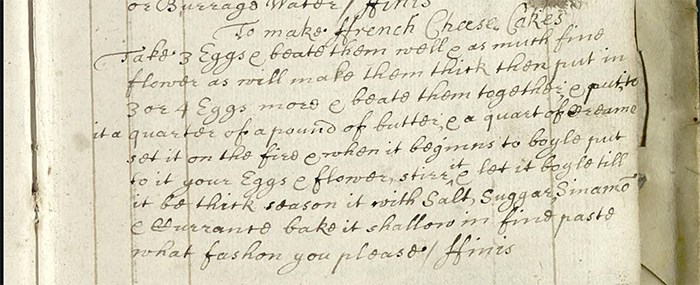
English Medicinal and Cookery, late 16th- mid 17th c., 27r.
French cheese cakes
The recipe we chose to make this time – French cheese cakes – was much trickier than the Tunbridge cakes we made earlier this summer.
flower as will make them thick then put in
3 or 4 eggs more and beat them together & put to
it a quarter of a pound of butter & a quart of creame
set it on the fire & when it beginns to boyle put
to it your Eggs & flower, stirr it & let it boyle till
it be thick season it with salt, suggar, sinnamon
& currants & bake it shallow in fine paste
what fashon you please // finnis.
From the Wangensteen Historical Library’s copy of English Medicinal and Cookery, late 16th- mid 17th c., call number: 27r. WZ240 E58 1540.
This recipe is interesting because it highlights some of the fundamental differences in the ways people cooked in the past, and the way many people cook today. Now, many people are accustomed to recipes that have very, very specific directions that leave little room for interpretation or customization. In the past, most cooks would have had a lot of tacit knowledge and would have been very comfortable reading basic directions and cooking largely from memory and their own personal preferences.
Like many early recipes, this recipe’s relatively unclear directions left us with many questions:
How much flour and eggs do we actually need? How thick should the mixture be? How much salt, sugar, cinnamon, and currants do we need to use? How long do you bake the cheesecake? At what temperature? What is “fine paste”?
Because of the level of interpretation we needed to bring to this recipe, we thought it would be a very interesting one to bring to our judges.
Our process
Although our ingredients were the exact same, we both used slightly different amounts since the recipe didn’t specify quantities.
The initial part of the recipe, mixing eggs with flour, butter, and cream, was relatively straightforward. We both decided to mix the eggs with the flour, and then separately mix the other eggs with the butter. Things became more complicated when the mixture went on the stove.
What the historical recipe doesn’t say is that heating eggs and dairy, eventually adding flour and sugar and spices, is somewhat tricky. You have to watch your mixture very carefully, stirring constantly, in order to make sure you end up with a delicious custard instead of sweet scrambled eggs! This is how Emily interpreted the directions:
Heat the milk and butter. Whisk the eggs, sugar, cinnamon, and salt separately. When the milk mixture is about to simmer (little bubbles will appear all around the edge of the pot), add the hot milk in ½-1 cup increments to the egg mixture while stirring constantly.
Once you’ve added 3 or so cups of milk mixture to the eggs, you can pour the egg mixture back into the rest of the hot milk, and continue to stir. Doing this instead of heating the eggs with the milk and butter from the outset will help to ensure that you don’t accidentally cook the eggs separately from the milk, which would leave you with milky scrambled eggs instead of custard.
When the whole mixture is back being heated on the stove, add the egg and flour mixture. Stir constantly. The mixture will thicken considerably. You can test whether it is done by dipping a spoon or rubber scraper in the mixture and running your finger through it. If the mixture stays in place rather than pooling back toward the center, it is done.
Emily baked her cheesecakes for judging in 2 8”, shallow pie plates. There was enough left over filling for a third pie, but she baked it crust-less in some ramekins. Emily’s pie crust was James Beard’s pastry for a 2 crust pie, and Katie used a recipe from All Recipes. Katie sprinkled cinnamon on top of her cheesecake to make sure the flavor was pronounced.
Once the cheesecakes had baked, WHL Curator Lois Hendrickson headed to our homes for contactless pickup and delivery to our celebrity judges.
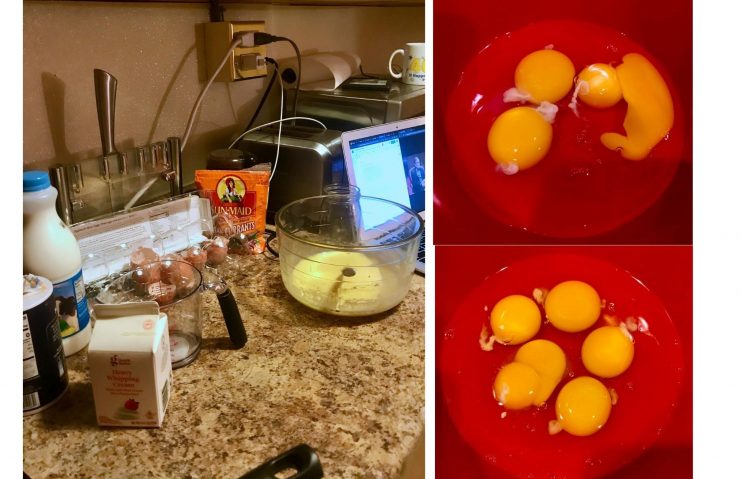
Katie’s ingredients on the left, Emily’s eggs on the right (including two eggs that had double yolks, which she viewed as good luck!
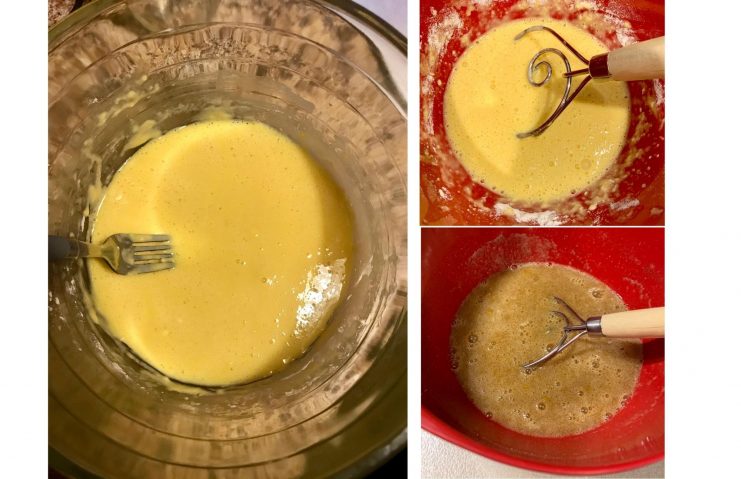
Katie’s cheesecake mixture on the left, Emily’s on the right.
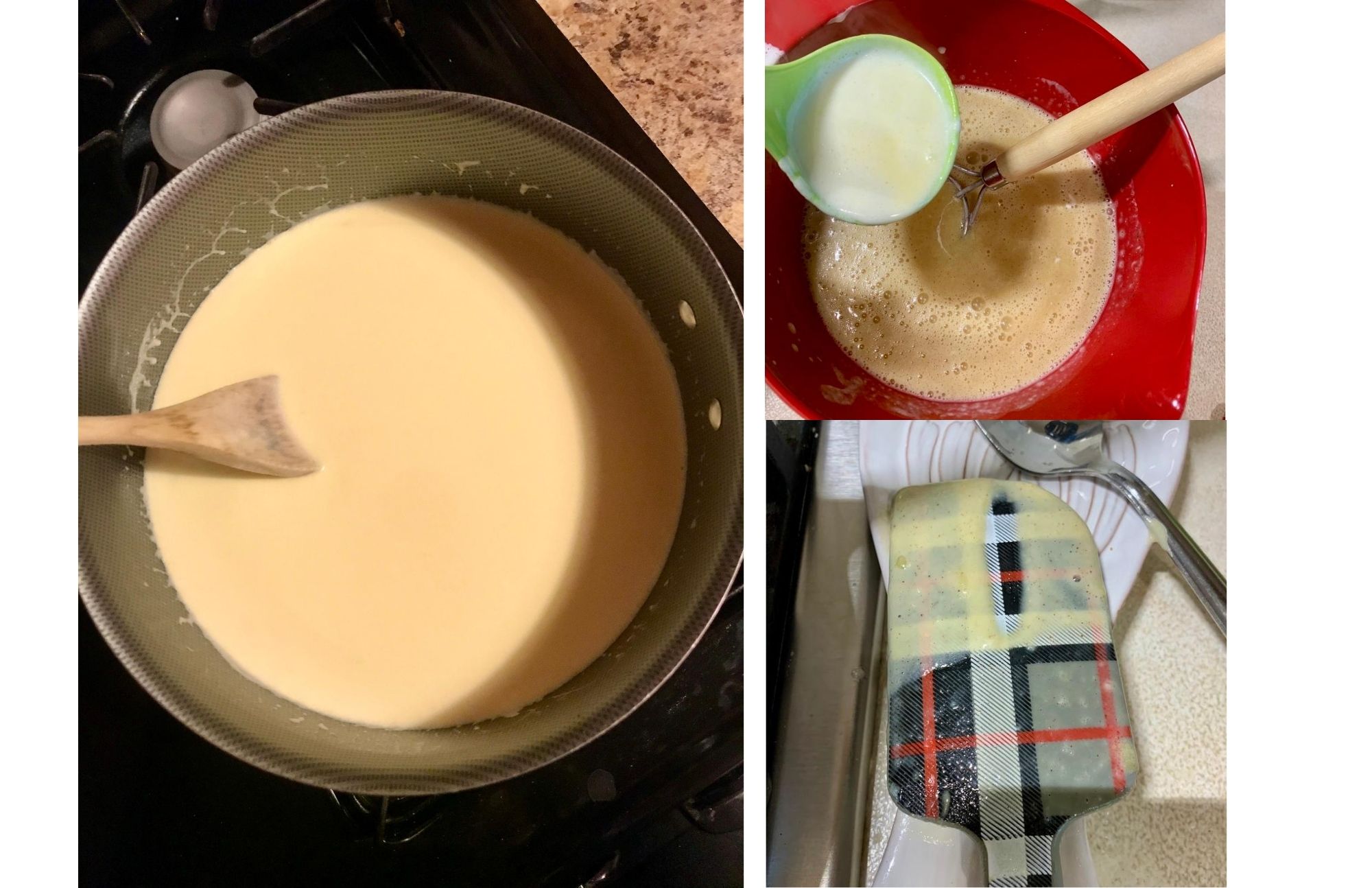
Katie’s cheesecake mixture on the left, Emily’s cheesecake mixture with hot milk being added is on the top right, and Emily’s rubber scraper showing the thickness of the mixture is on the bottom right.

Katie’s unbaked cheesecake on the left, Emily’s unbaked cheesecakes on the right.
Introducing the Lisas of the Libraries
 We were lucky to have four of the University Libraries’ Lisas to judge our historical cheesecakes. They bravely signed on for the task without even knowing what we would cook for them.
We were lucky to have four of the University Libraries’ Lisas to judge our historical cheesecakes. They bravely signed on for the task without even knowing what we would cook for them.
Lisa Calahan (top left) is the Head of Archival Processing in Archives and Special Collections.
Lisa German (top right) is the University Librarian and Dean of the University Libraries.
Lisa Johnston (bottom left) is the Research Data Management/Curation Lead and Co-Director of the University Digital Conservancy
Lisa McGuire (bottom right) is the Associate Director, Education & Research Services of the Health Sciences Libraries
The results
In general, our judges were impressed with the fact that we’d managed to make anything edible from this recipe.
They took their role seriously, however, and helped us figure out how our different techniques and ingredient amounts affected the final product. Here were some of the takeaways:
- Lisa McGuire said that the “textures were different – yours [Emily’s] was very smooth and creamy and almost falls apart in your mouth. Katie’s was more a little bit more textured, a little bit like flan.”
- Katie’s addition of cinnamon on top of her cheesecake paid off with Lisa Calahan’s comment that Emily’s cheesecake didn’t smell like anything! Katie’s smelled delicious.
- Lisa German noted that she and her family would happily actually eat this cheesecake again: “This was a perfect recipe for me, because it was just – it was savory enough, and just a light touch of sweetness.”
- Katie’s crust was the clear winner, with all four judges preferring it to Emily’s, but Emily’s cheesecake was the overall winner!
Thanks so much to our celebrity judges, and their families who also helped with cheesecake analysis. Stay tuned for more Wangensteen cook offs!
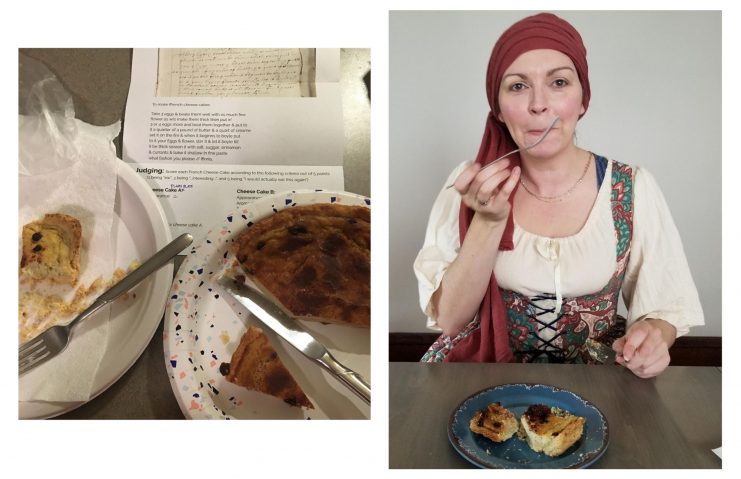
Lisa McGuire photographed Katie’s cheesecake (left) and Emily’s cheesecake (right) with the judging sheet in the image on the left. Lisa Johnston donned a historical costume for her tasting to ensure further historical accuracy.

Lisa Calahan and her family give thumbs up to 16th-century cheesecake!



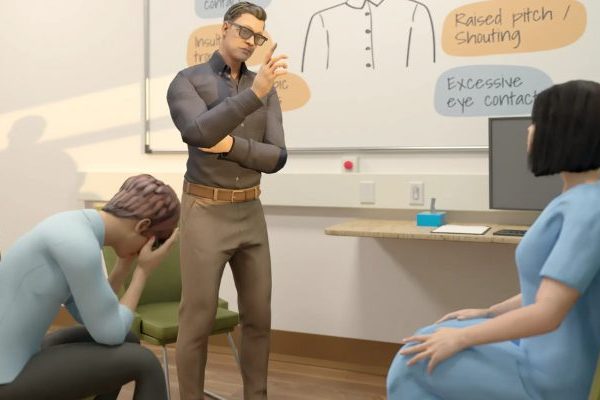
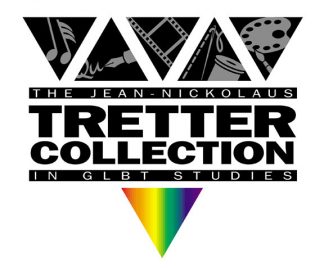
Dear Libraries’ Ladies Lisa,
Please note that I have dubbed you Ladies, of which you surely have earned, after doing all of your baking! Your article made me laugh and smile, thank you!
I have been going through my old recipe book, (although I am in my 7th decade and nowhere near as old as your recipes), cooking things that I have not cooked or baked for my family in years.
I have returned to the UMN to finish a long overdue degree, (with no help from Covid-19 and only one class left to finish) and find myself with lots of time to try out new recipes, of which yours is now at the top of the list!
By the way, perhaps you have all missed your calling and should be in the Food Science department!
I always enjoy reading all of the “continuum” articles that you publish, thank you!
I very much enjoy the re-creation of ancient recipes! What a fun project and the people involved make it so great to read about the dilemmas and outcomes. Thanks very much
Hi any chance we hungry readers could find out what quantities of each ingredient Katie & Emily used, so we could try to bake one at home?
Hi Debbie! I mixed 1/4 c. flour with 3 eggs, and used 4 eggs in the second step. The recipe calls for 1/4 lb of butter (1 stick) and a quart of cream (4 cups of heavy cream). I didn’t measure the salt, sugar, or cinnamon, but probably added half a teaspoon or so of salt, 1/3c. sugar, and a teaspoon of cinnamon. I used around 1/3c. currants, but I think you could definitely add more. If I made this recipe again, I would probably use dried cherries rather than currants, but I think you could use any kind of dried fruit you like. Let us know how your cheesecakes end up if you try this recipe!
I love the adventurous spirit and culinary detective work going on via the Libraries! I’d just read this last week…and last night, came upon this fascinating British site which explores many of the same sorts of dishes you’ve been seeing in the culinary books in the collection. This recipe looks like a version of the “cheesecake” you all took a crack at above— and it’s interesting to note the technique she uses for these gooseberry “pudding-pies”: https://dejafood.uk/2016/07/15/fruit-pudding-pies/
I wound up at the site while looking for recipes for Lancashire Butter Pie, by the way—a much simpler project!